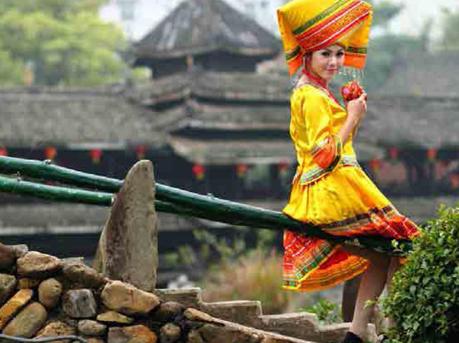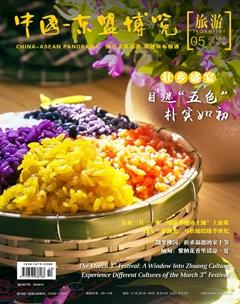The March 3rd Festival: A Window Into Zhuang Culture
By Jiang Yaqian



The Sanyuesan, or March 3rd Festival, aside from numerous festivals throughout the year, is one of the most widely observed festivals in southwest China. It is a great occasion for family reunion, ancestor worship and best wishes for the upcoming year. During the festival, grand festive activities such as song fair, bamboo pole dance and making colorful rice and eggs will definitely offer people a visual feast, especially for those city dwellers that are always busy with their work. And for outsiders, there are many exotic items to enjoy or appreciate. Therefore, no matter you are the locals or visitors, just let go of the worries that build up during the normal days and immerse yourselves in the fabulous festival.
Behind the festival
Falling on the third day of the third lunar month of the Chinese calendar, Sanyuesan, or March 3rd Festival, also called Shangsi Festival before Wei and Jin Dynasties (220-420), is celebrated by many nationalities such as Zhuang, Han, Yao, Dong, Miao, etc. There are many tales or mythologies behind this festival. As a Chinese saying goes “On February 2nd, the dragon raises its head; on March 3rd, Xuan Yuan was born”, legend has it that March 3rd in lunar calendar is the birthday of the Yellow Emperor — the ancestor of the Chinese, which serves as the reason why Han People celebrate it.
For Zhuang people, most of whom inhabit in south Chinas Guangxi Zhuang Autonomous Region, the March 3rd Festival used to be a day for outing by the water and singing folk songs. Likewise, the festival has its Zhuang version of origin from a mythological story about an old woman and an injured snake. After being saved by the kind woman, the snake decided to give up its tail to be her son. When the woman passed away on the third day of the third lunar month, the snake son expressed its appreciation by taking its human mother to the summit of Daming Mountain. Since then, extreme weather such as storms or hail often broke around Daming Mountain area on March 3rd, which was regarded by Zhuang people as an indication of the snake son coming to see its human mother. Therefore, Zhuang people hailed the old woman as the “Dragon Mother” and thought that Zhuang people living in Daming Mountain area were genuine “descendants of the dragon”. Nowadays, Zhuang people hold ceremonies on this day in memory of the “Dragon Mother” for her kindness, benevolence and maternity, as well as his son for its obedience.
Usually, people would put maple leaves into the cracks of the doors and windows on March 1st and prepare five-colored glutinous rice to worship their ancestors and the “Dragon Mother” on March 3rd. As an irreplaceable sacrifice, it is said that the glutinous rices colors derive from the snake son which had five colors on its skin, in memory of which, people dye rice with plants of different colors (usually red, yellow, purple, black and white). Zhuang people believe that the five-color glutinous rice can prevent human from disasters and illness and thus take it as a token of happiness and fortune. Nowadays, five-colored glutinous rice makes an integral part in observing the March 3rd Festival.
In 2014, the Zhuang March 3rd Festival was approved by the State Council to be listed as a National Intangible Cultural Heritage, which means that the festival has gained wide domestic and even international recognition. Since then, it not only offers Guangxi people a holiday to enjoy themselves in the grand festive activities, but also provides tourists at home and abroad with an opportunity to taste traditions and customs of Zhuang people.
Gexu — a feast for the ear
It is said that Zhuang people are born with singing and dancing talents, and their traditional folk songs can hence be inherited from generation to generation. During the March 3rd Festival, among the colorful festive activities, “Gexu” (song fair) could be said to be the most significant one, a songfest adored by both the young and old. According to folklore, “Gexu” is held to memorize Sister Liu Sanjie, a legendary Zhuang female singer who composed a lot of folk songs about labor, life and love. As a result, the March 3rd Festival is also known as Gexu Festival; and as the hometown of Liu Sanjie, Guangxi is accordingly renowned as “the ocean of folk songs”.
According to historical records, “Gexu” has a history of more than thousands of years. It is recorded in Universal Geography of the Taiping Era in the Northern Song Dynasty (960-1127) that “Around the time when crops grow ripe, Zhuang people will choose a day for a rite for gods, during which men and women will hold grand song fair.” These records demonstrate the emergence and prevalence of “Gexu” at that time. After the Song (960-1279) and Yuan (1271-1368) Dynasties, as the Zhuang folk songs experienced a notably rapid development, “Gexu” gradually turned into an occasion of cultural entertainment and romance between young boys and girls. By the Qing Dynasty (1636-1912), it already evolved into a magnificent feast with as many as thousands of participants, and has been well preserved to the present day.
This kind of song fair could last for two or three days, usually followed by activities such as bronze drum striking and bamboo dancing, all highlighting the folk traditions and customs and distinctive ethnic culture. After being dressed up, young boys and girls swarm to the singing stage, usually a vast open space in the village. During the song fair, in addition to the chorus performance, another distinctive activity is antiphonal singing, which is a form of characteristic folk art where different performers sing in alternation. For young people, antiphonal singing is a perfect chance to seek or pursue potential lovers. Usually, young boys should take the first to raise songs to girls they are into, and if the girls share the same feelings, they will respond positively to the boys through singing. In this way, “Gexu” acts as a medium of acquaintance with each other, where they communicate and express themselves through the sweet songs. With beautiful songs lingering in the air and gorgeous spring scenery around, peoples heart will be overflowed with sweet joy and happiness.
Embroidered balls and dyed eggs — the witness to love
The song fair is also accompanied by some other fascinating activities, with throwing embroidered balls as a typical one. Embroidered ball is a kind of folk handicraft popular with the Zhuang ethnic groups. Being exquisitely prepared by young girls before the festival, the embroidered ball, characterized by colorful appearance (mainly red, yellow, pink and green), has twelve connected “petals” on its surface, which symbolize the twelve months in a year. With beans or cotton seeds inside the ball, a ribbon with decorated tassels and beads that signify pure love is tied to the ball.
The embroidered ball represents a token of love. During the song fair, a girl could throw the embroidered ball to who she finds congenial as a sign of conveying affection. When the boy receives the embroidered ball, they could leave the song fair, exchanging other keepsakes as an emblem of promise. That is to say, receiving an embroidered ball marks the beginning of romantic relations between the boy and girl.
In some Zhuang regions, another way to express interest and love is to dye boiled eggs with different colors before the song fair. At the fair, a boy can use his dyed egg to touch the one in girls hands, and the girl can hold back her egg as a sign of rejection, or touch back intentionally to show her acceptance. If the girl shows an approving attitude, they can together have their eggs clashed and eaten, which means the seed of love has been sowed in their hearts. Whats more, clashing eggs also carries a meaning of “having good luck”.

